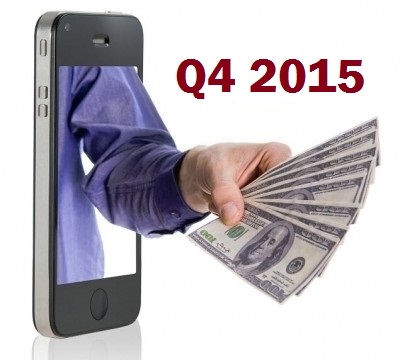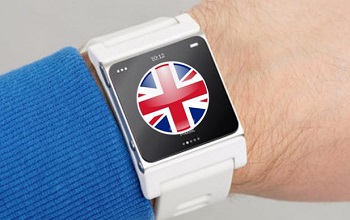The Adyen research firm has now released their figures which showed smartphones surpassed tablets in m-payments.
For the first time in the history of mobile payments, the last quarter of 2015 represented the time when smartphones were used more often than tablets for the completion of transactions that were made online.
At the same time, it remained iPads that were able to bring in the largest average transaction value.
The figures from Adyen, a research company, have also revealed that in the last three months of 2015, one in three online transactions were carried out in the form of mobile payments. The purchases were made either by way of a smartphone or a tablet. More specifically, 34 percent of online transactions during the last quarter of 2015 were completed over mobile. This was a solid increase over the third quarter of last year, when that figure had been 30 percent.
Mobile payments are currently divided nearly equally between smartphones and tablets, though phones are growing.
 In the worldwide scene, smartphones are being used for 17.5 percent of all purchase transactions completed online. This is an increase over the previous quarter, when it had been 14 percent. Comparatively, tablets were used 16 percent of the time, which is a decrease when compared to the quarter before, when it had been 17 percent.
In the worldwide scene, smartphones are being used for 17.5 percent of all purchase transactions completed online. This is an increase over the previous quarter, when it had been 14 percent. Comparatively, tablets were used 16 percent of the time, which is a decrease when compared to the quarter before, when it had been 17 percent.
What Adven determined was that even though smartphones were rising in popularity, it remained iPads that were being used for the transactions that had the highest overall total value. The average order value over iPads was $107. In second place – and only very slightly behind iPads – were orders made over laptops and PCs, as their average order value was $106. Android tablets took third place with $86, iPhones were in fourth place at $83 and, finally, Android smartphones had an average total purchase value of $73.
According to Roelant Prins, the chief commerce officer at Adven, in a recent statement, “Mobile payments, both in app and browser-based, are driving the growth of eCommerce, and this trend is particularly noticeable by the acceleration in mobile payments for methods such as JCB and Alipay.”
When compared to 2014, there was double the number of wearables purchased in the U.K. in 2015.
According to the data from the Mintel international market research firm, the number of wearable technology devices that were purchased in 2015 in the United Kingdom were about double the figure from 2014.
The company estimated that over a period of 12 months, people in the U.K. purchased 3 million wearables.
The wearable technology devices that were considered in these figures were smartwatches and fitness trackers. The total includes the devices purchased during the twelve months that followed September 2014. It’s important to note that, despite the tremendous growth that was recorded through these figures, they didn’t take into account the three months that included the holiday shopping season in 2015. Still, that period of one year still recorded a growth of 118 percent when compared to the twelve months previous to it. These figures align relatively accurately with the predictions that were made by IDC, last June.
Fitness trackers remain the most popular sub-category within the definition of wearable technology gadgets.
 IDC pointed out that the leader among fitness tracker wearables is, by far, Fitbit. It, therefore, remains the leader in wearable tech as a whole. The share fitness trackers held of the wearables market was currently estimated to be 63 percent, after having shipped 1.9 million devices last year. Comparatively, there have been 1.1 million smartwatches shipped in the United Kingdom, representing 37 percent of the market.
IDC pointed out that the leader among fitness tracker wearables is, by far, Fitbit. It, therefore, remains the leader in wearable tech as a whole. The share fitness trackers held of the wearables market was currently estimated to be 63 percent, after having shipped 1.9 million devices last year. Comparatively, there have been 1.1 million smartwatches shipped in the United Kingdom, representing 37 percent of the market.
When comparing these figures to the previous twelve month period, fitness trackers have seen their share shrinking. The year before the most recent results showed that fitness trackers made up 91 percent of all wearable tech sales. It was during that period that the Apple Watch was released into the U.K. market (April 2015), and a broad spectrum of different Android smartwatches also hit the shelves, such as the Moto 360 and Samsung Gear G2.
These provided consumers with more options outside of fitness trackers, allowing them to choose from among a larger range of wearable technology offerings. With more options, it’s easy to understand why fitness trackers lost some of their hold on the market as a whole in the United Kingdom.
 In the worldwide scene, smartphones are being used for 17.5 percent of all purchase transactions completed online. This is an increase over the previous quarter, when it had been 14 percent. Comparatively, tablets were used 16 percent of the time, which is a decrease when compared to the quarter before, when it had been 17 percent.
In the worldwide scene, smartphones are being used for 17.5 percent of all purchase transactions completed online. This is an increase over the previous quarter, when it had been 14 percent. Comparatively, tablets were used 16 percent of the time, which is a decrease when compared to the quarter before, when it had been 17 percent.
 IDC pointed out that the leader among fitness tracker wearables is, by far, Fitbit. It, therefore, remains the leader in wearable tech as a whole. The share fitness trackers held of the wearables market was currently estimated to be 63 percent, after having shipped 1.9 million devices last year. Comparatively, there have been 1.1 million smartwatches shipped in the United Kingdom, representing 37 percent of the market.
IDC pointed out that the leader among fitness tracker wearables is, by far, Fitbit. It, therefore, remains the leader in wearable tech as a whole. The share fitness trackers held of the wearables market was currently estimated to be 63 percent, after having shipped 1.9 million devices last year. Comparatively, there have been 1.1 million smartwatches shipped in the United Kingdom, representing 37 percent of the market.